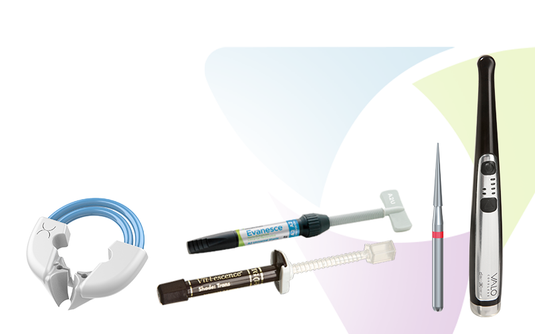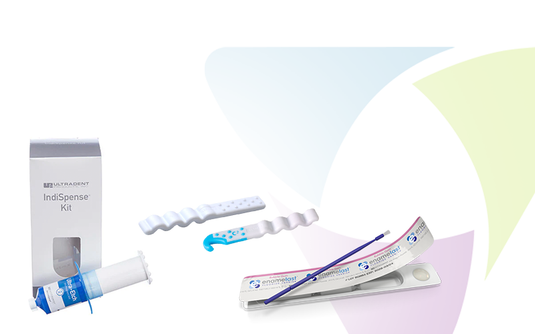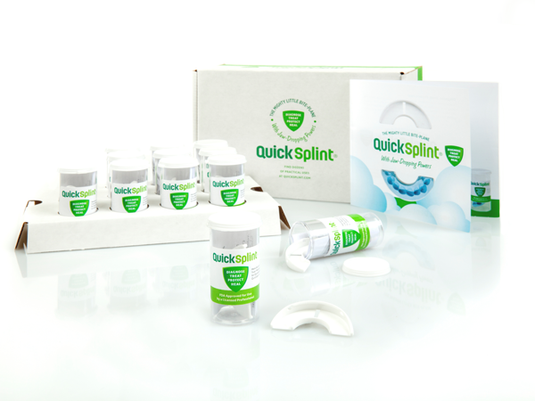
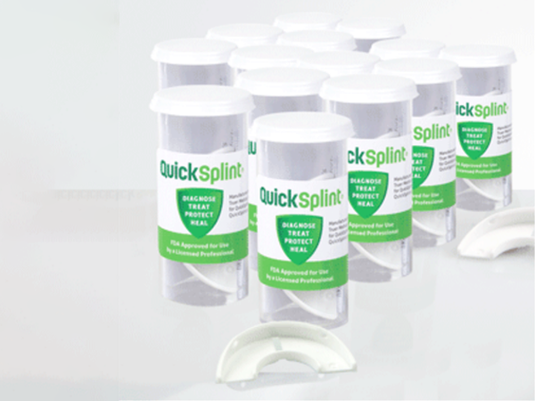
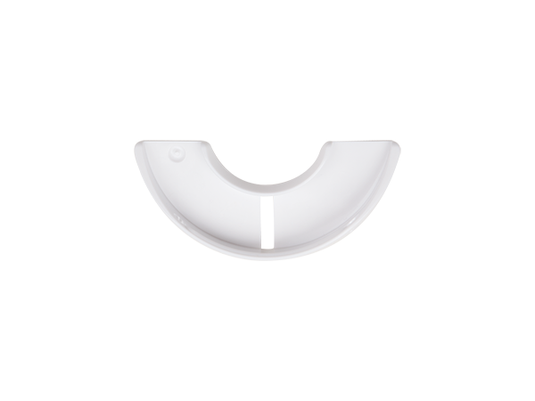
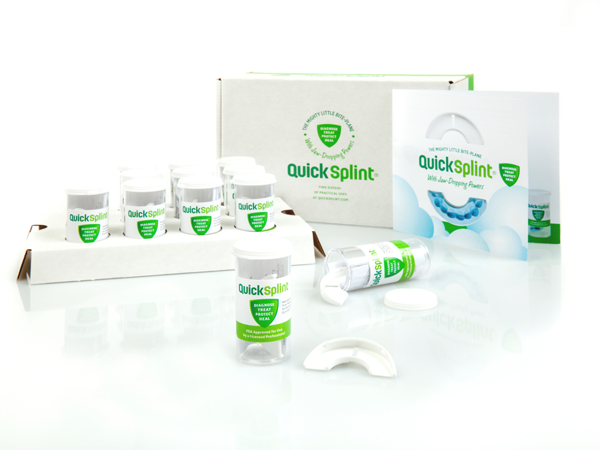
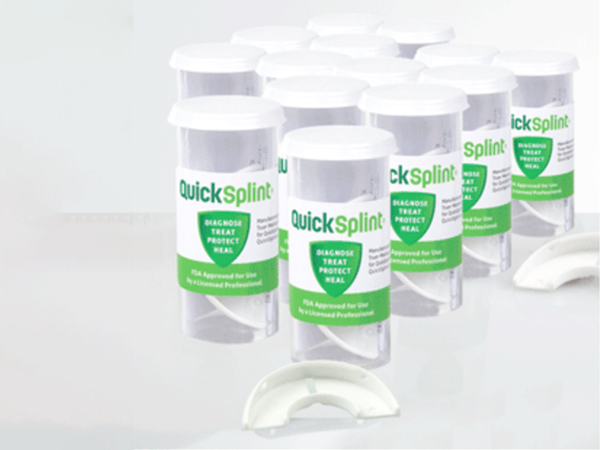
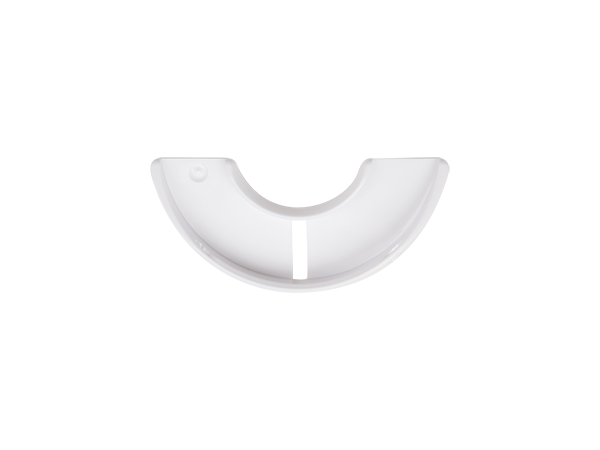
- Product Details
- Clinical Technique
- Technical Details
- Video
- Testimonials
- Configurations
- FAQ
- Resources
The quick and easy temporary splint that improves patient care.
QuickSplint is an occlusal splint designed for short-term use as an anterior bite plane and night guard. It is practical and easy to use and fabricated quickly in the dental practice at low cost. QuickSplint was developed by an orofacial pain specialist to initiate same-day treatment. The QuickSplint temporary bite plane makes it easier than ever to send your patients home with an immediate, comfortable solution to protect their teeth and new dental work and prevent tooth, jaw and facial pain. Other features and benefits include:
- Same-day treatment for acute jaw pain, orofacial pain
- Diagnostic aid for parafunction and bruxism
- Post-op healing aid to help jaw muscles relax and recover after dental treatment
- Post-op temporary protection for anterior provisional veneers, newly placed implants, periodontal surgery, endodontically treated teeth, and other new dental restorations
- Anterior bite-plane Deprogrammer
- Transitional or emergency appliance




TMJ
kettenbach

FILL

BITE DOWN

TRIM

READY TO USE
QuickSplint Technique
-
Note the lower anterior crowding.

-
Try in on maxillary arch. Note the uneven occlusal contacts due to lower crowding.

-
When QuickSplint is on the lower arch, occlusal contact is more evenly balanced.

-
Affinity Quick Bite is recommended for use when fabricating a QuickSplint appliance.

-
Fill the QuickSplint with Affinity Quick Bite.

-
Overfill the tray with Affinity Quick Bite. The retention slot and two holes should be filled to lock the lining into the tray without need of adhesives.

-
Using the retention slot to line up the midline ask the patient to bite down gently all the way into the tray. Wait for the Affinity Quick Bite to set.

-
Once Affinity Quick Bite has set the QuickSplint can be removed for trimming.

-
Trim the excess Affinity Quick Bite- a scapel is recommended to do so.

-
Fabricated and trimmed QuickSplint is ready to go in 5 minutes


80% of Patients with Bruxism Don't Know They Brux
It's easy to diagnose and engage your patients with QuickSplint!

Treating Jaw Pain can be Tricky
It's easier to diagnose and start treatment with a QuickSplint!

Deprogram Simply and Safely at Night
QuickSplint helps your patients transition to a long-term appliance.

Nighttime Occlusal Forces can Damage Dental Work
Ensure that temps and new veneers won't dislodge with QuickSplint!

Prevent Trismus for Higher-Risk Patients
Provide QuickSplint for post-op healing.
QuickSplint is a simple to use anterior bite plane that keeps the posterior teeth out of occlusion. See how the QuickSplint works to relax jaw muscles in this video.
A multi-purpose, custom fit bite place that takes only minutes to fabricate and has dozens of practical uses in Dentistry. Whether you are a general dentist or a specialist, QuickSplint comes to your aid to help diagnose, treat, protect and heal your patients.
Dr. Lee Ann Brady discusses the many practical uses of the QuickSplint interim oral appliance. Includes discussion of QuickSplint as a diagnostic tool for patients exhibiting tooth wear; its use as a tool to establish parafunction risk in selecting composite materials; its restorative and endo applications; along with using the QuickSplint interim oral appliance to treat jaw pain and headaches.
Dr. Olitsky is the Program Director at Clinical Mastery Series and teaches the many uses of QuickSplint in restorative dentistry. He is an expert Cosmetic Dentist with a practice in Ponte Vedra Beach, Florida.
"I’m using the QuickSplint for cosmetic cases. This includes everything from recording open bite centric occlusion records to provisional protection and final prosthesis protection. Used as a diagnostic tool, as a first line of treatment or as a step in treatment, QuickSplint is a valuable treatment tool"
John Weston, DDS
"I am having the patient wear QuickSplint for a week and then I do a post-op and assess the QuickSplint -- how it's holding up, where it's marking, how is the patient doing with it, any comfort/discomfort. Depending on those findings, I may have them wear it longer while I fabricate a longer-term occlusal guard."
Robert Gregg, DDS
"Muscular and endodontic pain happen in conjunction many times. Myogenic pain is very often confused as odontogenic pain. Endodontic treatment is unnecessarily completed and the patient’s pain remains. I use the QuickSplint as a non-invasive, inexpensive test to rule out muscular pain if I am uncertain about an endodontic origin. As a patient, I would much prefer a QuickSplint as a test instead of endodontic therapy as a test."
Rahim Karmali, DDS
"QuickSplint helps me provide my patients with a TMD appliance that can be inserted on the same day of my evaluation. This provides immediate protection of the temporomandibular muscles, joints, and teeth until a long-term splint can be placed. It is vitally important to prevent chronic TMD pain at the earliest onset of the condition. I use QuickSplint as a simple, effective solution."
James Fricton, DDS, MS
QuickSplint available in the following pack-sizes:
- 12-Pack (Item Number: 880106)
- 100-Pack (880108)
Q: Does QuickSplint Temporary Oral Appliance work for all patients?
A: QuickSplint temporary oral appliance is a conservative first step in the diagnosis and treatment of acute jaw pain and/or bruxism. However, there are patients for which QuickSplint is not appropriate. Read all instructions prior to prescribing.
Q: Is QuickSplint Temporary Oral Appliance used on the upper or lower arch?
A: QuickSplint temporary oral appliance can be fit for either upper or lower arch; we recommend that you identify which arch has the more level tooth contact and make QuickSplint for the opposing arch. For post-surgery application, use QuickSplint temporary oral appliance on the opposing arch, and trim the VPS to be entirely tooth borne.
Q: How long can a patient wear QuickSplint temporary oral appliance?
A: It is recommended that QuickSplint temporary oral appliance be used for between 4 to 6 weeks, until the patient no longer needs it, or is transitioned to a long-term appliance. There are circumstances where a patient might be prescribed QuickSplint for a period of up to several months, such as a patient that is undergoing a complex treatment plan where it would be impractical to fit the patient for a long-term appliance between phases of treatment.
Q: Is QuickSplint only worn at night? Or can QuickSplint be used during the day as well?
A: QuickSplint temporary oral appliance is to be used primarily when sleeping to prevent pain or damage to teeth (or restorations) caused by nighttime occlusal forces. The prescriber may suggest that QuickSplint temporary oral appliance be worn during the day as well for pain relief or to promote healing from surgical procedures, such as periodontal surgery, implant placement, and third molar extraction. QuickSplint temporary oral appliance is not recommended for continuous daytime wear of over two weeks.
Q: What is QuickSplint temporary oral appliance made of?
A: QuickSplint temporary oral appliance has two components: A) a rigid biocompatible plastic shell that is filled with bite registration material to customize each appliance to supporting dentition, and B) an insert of fast-set Poly Vinyl impression material (VPS).
Q: How should QuickSplint be cleaned?
A: Clean QuickSplint temporary oral appliance daily by rinsing thoroughly under tap water. Dry the QuickSplint by shaking the excess water from the surface and allow to air dry. When needed, clean QuickSplint using an ultra-soft toothbrush or by gently washing with water. You may periodically disinfect your QuickSplint temporary oral appliance by soaking in a half and half mixture of mouthwash and water for ten minutes. Do not clean QuickSplint temporary oral appliance in boiling water, denture cleaner, or soak it in hydrogen peroxide.
Q: Are there contra-indications for the use of QuickSplint temporary oral appliance?
A: QuickSplint temporary oral appliance may not be suitable for all patients. QuickSplint should be used with care in patients with jaw mobility of less than 25mm or greater than 60mm. QuickSplint temporary oral appliance should not be fit on or over broken or loose teeth.
Q: Can QuickSplint temporary oral appliance be used for dental emergencies?
A: QuickSplint temporary oral appliance can be used for dental emergencies and acute pain as it relates to TMD, sprained jaw, tension headache, or other facial pain. QuickSplint is also an effective emergency splint for the patient who has lost their appliance and needs an occlusal guard while a new one is being fabricated. QuickSplint is not for emergencies involving broken teeth or trauma. Never fit QuickSplint temporary oral appliance over loose or broken teeth. Read complete product instructions before use.
Q: What if the soft lining material disengages from the tray?
A: If the soft lining material disengages from the tray, return to your prescriber for replacement of the liner. Do not attempt to glue the liner to the tray.
View the QuickSplint Product Sheet.
View the QuickSplint Technique Guide.
View the QuickSplint Tips for Success.
View the QuickSplint Perscriber IFU.
View the QuickSplint Patient IFU.
View article When the Jaw Hurts Speed-to-Treat with QuickSplint.
View article Addressing Parafunction with QuickSplint from ExpertTrends featuring Lee Ann Brady, DMD.
View article Improving Success with Your Cosmetic Cases using QuickSplint from cosmetic dentistry featuring Dr. John Weston.

